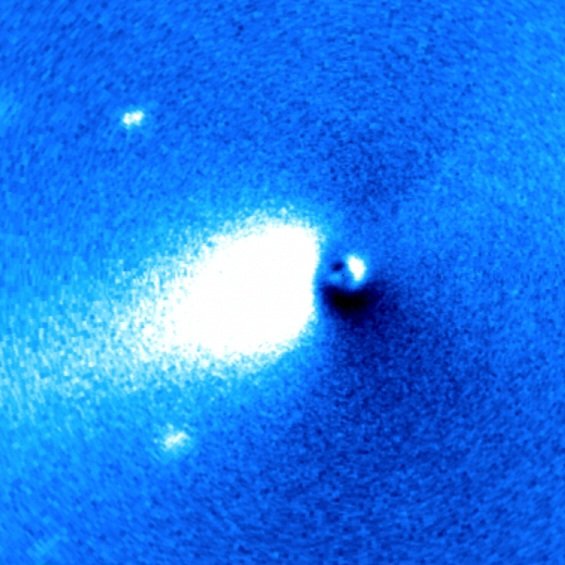
By Samuel Lopez | USA Herald
The newly released Nordic Optical Telescope image of 3I/ATLAS from November 11, 2025 — captured by astronomers David Jewitt and Jane Luu — may be the most visually unsettling and anomalous picture of the interstellar object to date. This frame shows structural behaviors that are not only rare for natural comets, but in several cases, difficult to categorize under any known cometary physics.
At first glance, the image appears to show a typical comet-like glow, but a closer inspection reveals phenomena that simply do not align with normal cometary physics.
The most striking feature is the enormous jet erupting directly toward the Sun. In natural comets, jets almost always point away from the solar direction because heat-driven outgassing pushes material outward. Yet in this frame, 3I/ATLAS is releasing its brightest, most concentrated plume into the very region where solar radiation is strongest. Such a sunward jet is mechanically and thermodynamically counterintuitive, and it adds to the growing list of behaviors that distinguish this object from any known interstellar visitor.
At the center of the image, the nucleus displays an even more unsettling characteristic: a dark, circular region embedded inside an intensely bright core. Rather than being uniformly overexposed, as is common when observing active comets, the nucleus of 3I/ATLAS appears to contain a shadowed or hollowed feature—a nearly perfect dark spot surrounded by a saturated luminous boundary. This type of central morphology is not something documented in the standard behavior of comets, asteroids, or fragmenting icy bodies. It looks deliberate, structured, and sharply defined in a way that raises significant questions about the object’s composition and internal geometry.
The brightness of the primary jet is so extreme that it saturates the telescope’s detector, producing a dense white flare that obscures fine details and signals a tremendously powerful, concentrated release of material. Rather than forming a diffuse fan or broad cone, the jet is sharply aligned, tightly focused, and almost beam-like in appearance. Natural jets tend to spread, disperse, and form irregular patterns due to rotational motion and inconsistent surface heating. Here, the plume maintains a rigid axis and a defined boundary, giving it a distinctly engineered or collimated appearance rarely observed in natural bodies.
Around the nucleus, the image also captures smaller secondary bright regions that do not appear to be background stars. Their relative symmetry and proximity to the central jet have raised questions among observers about whether these are fragments, reflective debris, or additional emission points. The possibility that 3I/ATLAS broke apart at perihelion has been discussed in scientific circles, but the clean distribution and brightness of these surrounding points complicate that explanation.
The coma—the cloud of dust and gas encasing the object—shows clear signs of asymmetry. Instead of forming a rounded halo, the coma is distorted, stretched, and pulled in the same direction as the major jet. This irregular shape suggests rapid tumbling, directional thrust, or non-gravitational acceleration acting upon the object. Such behavior aligns with the earlier measurements showing that 3I/ATLAS is not following a purely gravity-driven path through the Solar System.
Perhaps the most visually striking anomaly is the fact that the brightest region in the image is not centered on the nucleus. Rather than radiating outward in a symmetrical pattern, the highest-intensity glow is offset and elongated, reinforcing the impression that 3I/ATLAS is shedding material in a highly directional and uneven manner. This again contradicts the expected behavior of a natural comet undergoing solar heating and suggests a different underlying mechanism driving the mass loss.
Taken together, the sunward jet, the darkened central cavity, the saturated and highly collimated plume, the secondary bright structures, the asymmetric coma, and the off-center luminosity form an image that defies simple explanation. Each feature alone would be unusual; combined, they elevate this Nordic Optical Telescope capture to one of the most significant—and perplexing—visual data points in the ongoing study of 3I/ATLAS.
This image does not just deepen the mystery surrounding the object; it challenges the assumptions many scientists have used to categorize it. For USA Herald readers following this story since its discovery, this photograph stands as one of the clearest pieces of evidence yet that 3I/ATLAS is not behaving like a natural interstellar traveler.


